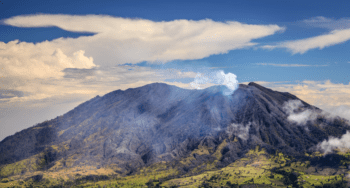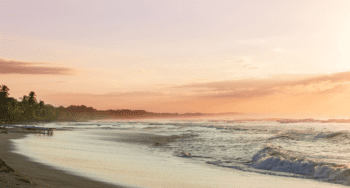Costa Rica Beaches: What's Covered
Costa Rica’s 800+ miles of coastline is split between the Pacific and the Caribbean, offering world-class surf to calm family swimming. Guanacaste’s Pacific beaches deliver dry-season sunshine December-April with Tamarindo for beginner surfing and Conchal for snorkeling. Manuel Antonio sits 3 hours from San José, combining beaches with wildlife, while Puerto Viejo offers Caribbean culture and coral reefs. Vehicle selection determines access—standard cars work for major destinations, remote beaches need 4×4.
Quick Facts:
- Pacific: 600+ miles, dry Dec-Apr, better infrastructure and sunsets
- Caribbean: 130 miles, year-round tropical, less crowded, with a unique culture
- Liberia Airport reaches Guanacaste in 1-2 hours; San José for the Central Pacific in 3 hours
- Arrive before 8 AM for the calmest conditions and parking
- The green season brings lower prices and brief afternoon showers
Top 3 Destinations:
- Tamarindo – Beginner surf, walkable restaurants, 1.5 hours from Liberia
- Manuel Antonio – Four park beaches with sloths, arrive early for parking
- Puerto Viejo – Reggae culture, reef snorkeling, 4 hours via mountain roads
Planning your strategy: single beach for 7 days or less, multiple beaches for 10+ days. Remote spots like Tortuguero need boat access.
If you need any help with a Costa Rica car rental, contact us now!
Looking for the perfect Costa Rican playa (beach) but feeling overwhelmed by options? You’re not alone. With over 800 miles of coastline split between two very different oceans, choosing where to spend your beach days can make or break your vacation.
Here’s the insider scoop on Costa Rica’s best beaches, from world-class surfing breaks to family-friendly swimming spots. I’ll walk you through what each coast offers, when to visit, and most importantly – how to actually get there without spending half your vacation in transit.

Pacific or Caribbean: Which Coast Actually Fits Your Travel Style?
Costa Rica’s two coastlines might as well be different countries. The Pacific side stretches for over 600 miles and offers everything from luxury resort beaches to remote surf breaks. The Caribbean coast runs just 130 miles but packs incredible cultural diversity and unique ecosystems into that shorter stretch.
Pacific Coast highlights:
- Consistent dry season (December-April) with reliable sunshine
- Better infrastructure and more accommodation options
- World-renowned surfing destinations
- Dramatic sunsets every evening
- More developed beach towns with restaurants and activities
Caribbean Coast highlights:
- Year-round tropical climate with afternoon showers
- Strong Afro-Caribbean culture and cuisine
- Excellent snorkeling and diving opportunities
- Less crowded and more authentic local experiences
- Unique wildlife including sloths and poison dart frogs
The choice between coasts often comes down to your travel style and timing. Pacific beaches work better for those seeking reliable weather and extensive amenities, while the Caribbean appeals to travelers wanting cultural immersion and fewer crowds.

Why Do Most Beach Lovers Choose Guanacaste?
Guanacaste province dominates Costa Rica’s northern Pacific region, offering the country’s driest climate and most developed beach infrastructure. This area receives the least rainfall annually, making it ideal for travelers who prioritize sunshine over everything else.
Tamarindo: The Surfing Capital
Tamarindo has evolved from a sleepy fishing village into Costa Rica’s most famous beach town. The main playa offers excellent beginner surfing conditions year-round, while the town provides restaurants, nightlife, and tour operators within walking distance.
Local ticos (Costa Ricans) still surf here daily at dawn, and you’ll quickly learn why the morning sessions before 8 AM offer the best waves and calmest conditions.
Why Tamarindo dominates surf discussions:
- Forgiving waves perfect for first-time surfers
- Restaurants and bars within stumbling distance of the beach
- Tour operators for every adventure imaginable
- Infrastructure that actually works (reliable WiFi, ATMs, pharmacies)
Getting there: About 1.5 hours from Liberia Airport (LIR) on mostly paved roads. A standard car works fine during dry season, though a 4×4 provides more flexibility for exploring nearby playas.
Local custom: Ticos typically hit the beach early (6-8 AM) and late afternoon (4-6 PM) to avoid the intense midday sun. Follow their lead for the most comfortable beach experience.
Best time to visit: December through April for guaranteed sunshine, or May through August for fewer crowds and lower prices.
Playa Conchal: The Shell Beach
Just south of Tamarindo, Playa Conchal gets its name from the millions of tiny shells that create its distinctive white sand. The calm waters make it perfect for families, while the nearby Westin resort provides upscale amenities.
Conchal’s secret advantage:
- Those millions of tiny shells create genuinely comfortable beach walking
- Protected waters stay calm when other beaches turn choppy
- Snorkeling reveals tropical fish just meters from shore
- Significantly fewer vendors and beach walkers than Tamarindo
Getting there: 20 minutes south of Tamarindo via a mix of paved and gravel roads. Any vehicle can access the main beach area.
Peninsula Papagayo: Luxury Resort Territory
The Papagayo Peninsula represents Costa Rica’s most exclusive beach destination. Multiple luxury resorts line secluded coves with pristine white sand beaches and calm waters protected from Pacific swells. You don’t have to stay at one of the resorts to access the beaches.
Papagayo’s luxury equation:
- Seven distinct beaches, each with different personalities
- Water temperatures that rarely drop below 80°F (27°C)
- Resort staff who anticipate your needs before you voice them
- Sport fishing that regularly produces magazine-worthy catches
Getting there: 30 minutes from Liberia Airport on well-maintained roads. All vehicle types can access the main resort areas.
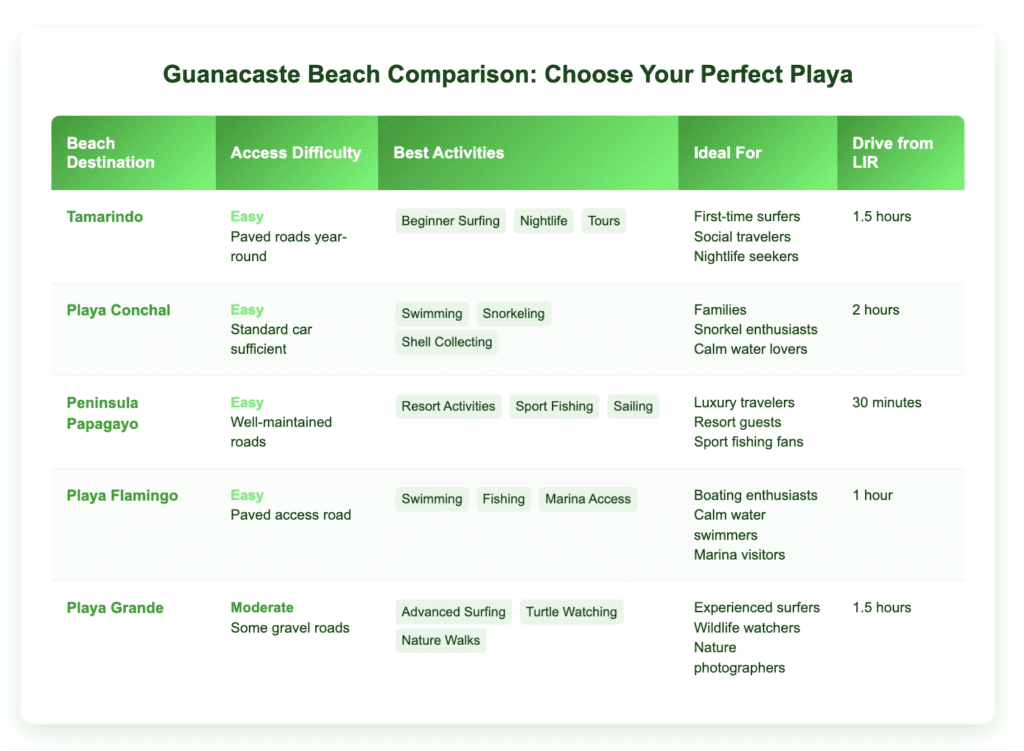
Need Quick Beach Access from San José?
The Central Pacific offers Costa Rica’s most accessible beach experiences, with several destinations reachable within 2-3 hours from San José. This region balances natural beauty with tourism infrastructure better than anywhere else in the country.
Manuel Antonio: Where Rainforest Meets Beach
Manuel Antonio National Park combines stunning beaches with incredible wildlife viewing opportunities. Four beaches within the park boundaries offer different experiences, from family-friendly swimming to dramatic tide pools.
Manuel Antonio’s winning combination:
- Sloths hanging literally above beach chairs
- Four distinct beaches offering everything from family swimming to powerful surf
- Restaurant quality that rivals major cities
- Hiking trails where you’ll spot more wildlife than most dedicated nature reserves
Getting there: 3 hours from San José via the coastal highway. The road is fully paved but includes mountain sections with switchbacks. Any vehicle type works, though parking near the park entrance fills quickly during peak season.
Insider tip: Visit early morning (7-8 AM) to see the most wildlife activity and secure parking. Afternoon visits often mean circling for 30+ minutes looking for spots. Locals call the midday period “la hora del sol fuerte” (the strong sun hour) – when smart beachgoers retreat to shade.
Jacó: The Party Beach
Jacó attracts younger crowds with its vibrant nightlife scene and consistent surf breaks. The long stretch of dark sand provides plenty of space, while the town offers Costa Rica’s most active beach nightlife.
Jacó’s reputation isn’t accidental:
- Surf breaks that work for intermediate surfers year-round
- Nightlife that doesn’t shut down at 9 PM like most Costa Rican towns
- Drive time from San José that won’t eat your entire day
- Beach scene that attracts younger crowds seeking social energy
Getting there: 1.5 hours from San José on a well-maintained highway. Standard vehicles handle the route easily year-round.
Dominical: The Laid-Back Alternative
South of Manuel Antonio, Dominical maintains a more relaxed atmosphere while offering excellent surfing and proximity to spectacular waterfalls and rainforest hikes.
Dominical delivers authenticity:
- Local atmosphere where Costa Ricans still outnumber tourists
- Waves that challenge even experienced surfers
- Waterfalls within 30 minutes that put most tourist attractions to shame
- Accommodation prices that won’t destroy your budget
Getting there: 3.5 hours from San José. The final 45 minutes includes mountain roads, so a 4×4 provides more confidence during green season.

Want Pristine Beaches Away from Crowds?
The southern Pacific coast requires more effort to reach but rewards visitors with some of Costa Rica’s most pristine and dramatic beaches.
Osa Peninsula: Pristine Wilderness Beaches
The Osa Peninsula hosts beaches that feel completely untouched, surrounded by primary rainforest that extends right to the shoreline. These beaches require significant travel commitment but offer unmatched natural beauty.
Access considerations: The journey to Osa Peninsula beaches involves 4-6 hours of driving from San José, including the final hour on unpaved roads. A 4×4 vehicle is absolutely essential, especially during the green season.
Osa Peninsula rewards effort:
- Beaches where your footprints join only those of raccoons and coatis from the night before
- Scarlet macaws flying overhead while you body surf
- Fishing opportunities that attract anglers from around the world
- Direct access to Corcovado National Park’s legendary biodiversity
Uvita: Whale Watching Central
Uvita’s main attraction is the seasonal humpback whale migration, visible from shore during peak months. The beach itself features a distinctive whale tail-shaped sandbar at low tide.
Getting there: 4 hours from San José via the coastal highway. Roads are paved but include mountain sections requiring careful driving.
Best time to visit: August through October and December through March for whale watching opportunities.

Looking for Cultural Immersion with Your Beach Time?
Costa Rica’s Caribbean coast offers a completely different beach experience, influenced by Afro-Caribbean culture and characterized by different weather patterns and ecosystems.
Puerto Viejo: Caribbean Culture and Coral Reefs
Puerto Viejo combines excellent beaches with the strongest Caribbean cultural influences in Costa Rica. The town pulses with reggae music, local cuisine features coconut-based dishes, and English-speaking locals reflect the region’s Jamaican heritage.
Puerto Viejo’s Caribbean soul:
- Reggae rhythms spilling from beachfront bars at sunset
- Local dishes featuring coconut that taste nothing like Pacific coast food
- Coral reefs close enough to swim to from shore
- Conversations in English, Spanish, and Jamaican patois flowing naturally
Getting there: 4 hours from San José through spectacular mountain scenery via Braulio Carrillo National Park. The road is fully paved but includes steep sections and frequent curves.
Cahuita: National Park Beaches
Cahuita National Park protects one of Costa Rica’s most accessible coral reef systems along with beautiful white and black sand beaches. The laid-back town offers a quieter alternative to Puerto Viejo.
Cahuita’s natural advantages:
- Snorkel tours in the National Park
- Coral reefs that create natural swimming pools
- Hiking trails where sloths move so slowly you’ll spot them easily
- Prices that make Puerto Viejo look expensive
Getting there: 3.5 hours from San José via the same route as Puerto Viejo. Standard vehicles work fine on the main highway.
Manzanillo: End-of-the-Road Tranquility
At the end of the coastal road south of Puerto Viejo, Manzanillo offers the most remote accessible beach experience on the Caribbean coast. The Gandoca-Manzanillo Wildlife Refuge protects both marine and terrestrial ecosystems.
Manzanillo’s end-of-the-road appeal:
- Beaches where development stopped decades ago
- Wildlife refuge trails starting directly from the sand
- Snorkeling conditions that improve the further you swim from shore
- Fishing village rhythms unchanged by tourism trends
Getting there: 4.5 hours from San José, including 30 minutes on gravel road from Puerto Viejo. A 4×4 isn’t required but provides more confidence on the final stretch.

How Do You Actually Get to These Beaches?
Your beach choice significantly impacts transportation logistics. Here’s how to plan efficiently:
Which Airport Gets You to Beaches Faster?
Choose Liberia Airport (LIR) if your priority beaches include:
- Tamarindo and surrounding Guanacaste beaches (1-2 hours)
- Peninsula Papagayo luxury resorts (30 minutes)
- Santa Teresa and Montezuma (2.5 hours including ferry)
Choose San José Airport (SJO) if targeting:
- Manuel Antonio and Central Pacific beaches (3 hours)
- Caribbean coast destinations (3.5-4 hours)
- Southern Pacific beaches like Dominical (3.5-4 hours)
For detailed airport selection guidance, check our Choosing the Right Costa Rica Airport guide.
Do You Actually Need a 4×4 for Beach Access?
Standard car sufficient:
- Major Guanacaste beaches (Tamarindo, Conchal, Flamingo)
- Manuel Antonio and Jacó
- Main Caribbean coast towns (Puerto Viejo, Cahuita)
4×4 recommended or required:
- Remote Osa Peninsula beaches
- Santa Teresa and Montezuma (especially during green season)
- Any beach exploration during heavy rain periods
- Beaches accessed via unpaved roads
For comprehensive vehicle selection advice, see our Costa Rica Car Rental Guide: Choosing the Right Vehicle.
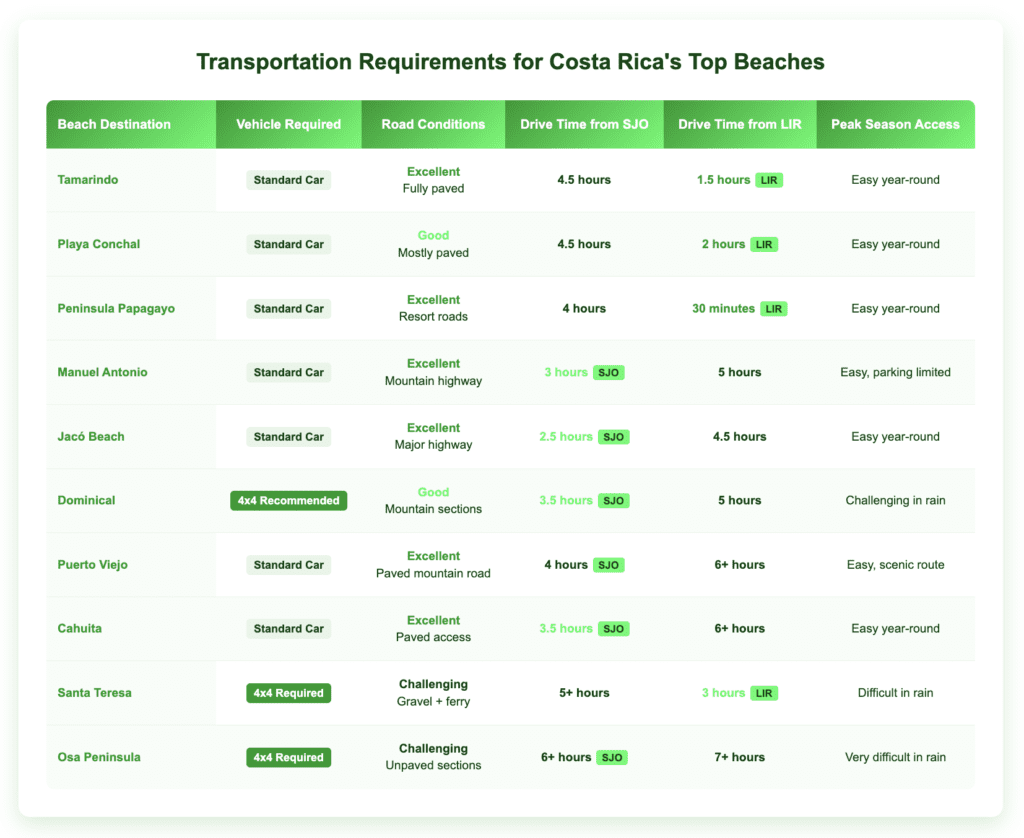
How Do Seasons Affect Beach Road Conditions?
Dry season (December-April):
- All beaches accessible with appropriate vehicles
- Dusty conditions on unpaved roads
- Peak traffic to popular destinations
Green season (May-November):
- Some remote beaches become challenging to access
- Afternoon rains can create muddy conditions
- Significantly less traffic but requires more careful planning
Which Beaches Work Best for Your Favorite Activities?
Different beaches excel at different activities. Here’s how to match your interests with the right destinations:
Where Should Surfers Actually Go?
Beginner-friendly:
- Tamarindo (consistent, forgiving waves)
- Jacó (reliable breaks, surf schools nearby)
- Dominical (slightly more challenging but great for progression)
Intermediate to advanced:
- Salsa Brava at Puerto Viejo (powerful reef break)
- Witch’s Rock near Tamarindo (requires boat access)
- Pavones (legendary left-hand point break, southern Pacific)
Which Beaches Are Actually Safe for Swimming?
Calmest waters:
- Playa Conchal (protected by offshore reefs)
- Peninsula Papagayo beaches (sheltered coves)
- Manuel Antonio’s Playa Espadilla Sur (inside national park)
Beaches to approach with caution:
- Most Pacific beaches have strong currents
- Always check with locals about current conditions
- Avoid swimming alone, especially at remote locations
Where Can You Actually See Fish While Snorkeling?
Best underwater visibility:
- Cahuita National Park (coral reef protection)
- Manzanillo (clear Caribbean waters)
- Peninsula Papagayo (calm conditions, good visibility)
Marine life highlights:
- Caribbean coast: tropical fish, sea turtles, small sharks
- Pacific coast: rays, puffer fish, occasional dolphins

What Should You Actually Pack for Costa Rica Beaches?
What Should You Actually Bring
Beach day necessities that locals never forget:
- Sunscreen with serious SPF (the equatorial sun doesn’t mess around)
- More water than you think you need (dehydration happens fast in tropical heat)
- Cash for beach vendors and parking (many beaches charge small fees)
- Snacks that won’t melt (beach restaurants cluster around popular spots only)
- Waterproof phone protection (salt spray reaches further than expected)
Additional items for remote beaches:
- First aid supplies
- Extra water and food
- Fully charged phone with offline maps
- Emergency contact information
Safety Considerations
- Pacific beaches often have strong currents and powerful waves
- Caribbean beaches generally offer calmer swimming conditions but stay alert for riptides
- Always ask locals about current conditions before swimming
- Never swim alone, especially at isolated beaches
Beach security:
- Don’t leave valuables visible in vehicles
- Use hotel safes for passports and extra cash
- Be aware of surroundings, especially at isolated locations
- Stick to well-traveled beaches after dark
When Should You Visit Each Beach for the Best Experience?
Dry Season Beach Benefits (December-April)
Best for:
- Guaranteed sunshine for beach days
- Calm ocean conditions on many Pacific beaches
- Peak wildlife activity (easier animal spotting)
- Reliable road conditions to all destinations
Expect:
- Higher accommodation prices (20-40% premium)
- Crowded conditions at popular beaches
- Advanced booking requirements
- Dusty conditions on unpaved access roads
Green Season Beach Advantages (May-November)
Best for:
- Lower accommodation rates and fewer crowds
- Lush, green landscapes surrounding beaches
- Better surfing conditions on Pacific coast
- More authentic local interactions
Consider:
- Afternoon rain showers (usually brief)
- Some remote beaches become harder to access
- Higher humidity levels
- Occasional flight delays due to weather
For detailed seasonal information, check our Costa Rica’s Regional Weather Patterns guide.

Should You Focus on One Beach or Try Beach Hopping?
Single Beach Focus vs. Multiple Beach Strategy
Single beach base (recommended for 7 days or less):
- Choose one region and explore thoroughly
- Allows deeper local connections and relaxation
- Reduces time spent driving between destinations
- Better value with longer stays at accommodations
Multiple beach strategy (works for 10+ day trips):
- Plan logical routes to minimize backtracking
- Allow full days for longer drives (4+ hours)
- Book accommodations well in advance
- Consider domestic flights for distant destinations like Tortuguero
Strategic Route Planning
Efficient Pacific coast route: San José → Manuel Antonio (3 hours) → Dominical (1 hour) → return via same route
Guanacaste beach hopping: Liberia Airport → Tamarindo (1.5 hours) → Conchal (20 minutes) → Peninsula Papagayo (45 minutes)
Caribbean coast exploration: San José → Puerto Viejo (4 hours) → Cahuita (20 minutes) → Manzanillo (30 minutes)
Beach-Specific Insider Tips
Manuel Antonio National Park
Arrive before 7 AM to secure parking and see the most wildlife activity. The park limits daily visitors, so buying tickets online in advance prevents disappointment during peak season.
Hidden gem: Playa Playitas, just south of the national park, offers similar scenery with fewer crowds and no entrance fees.
Tamarindo
The main beach gets crowded by mid-morning. For a more peaceful experience, walk north along the beach to find quieter sections, or visit Playa Grande (5 minutes by car) for a completely different atmosphere.
Local secret: Sunset viewing is best from the rocky outcropping at the north end of the main playa, not from the central restaurant area where most tourists gather. Locals call this spot “la punta” (the point) and it’s where you’ll find the best photo opportunities without crowds.
Puerto Viejo
The best Caribbean coast weather typically occurs in the morning before afternoon clouds roll in. Plan beach time early and save cultural activities like visiting the local mercado (market) for later in the day.
Don’t miss: Try Caribbean coast specialties like rice and beans cooked in coconut milk at a local soda (small family restaurant) – it’s completely different from Pacific coast cuisine.
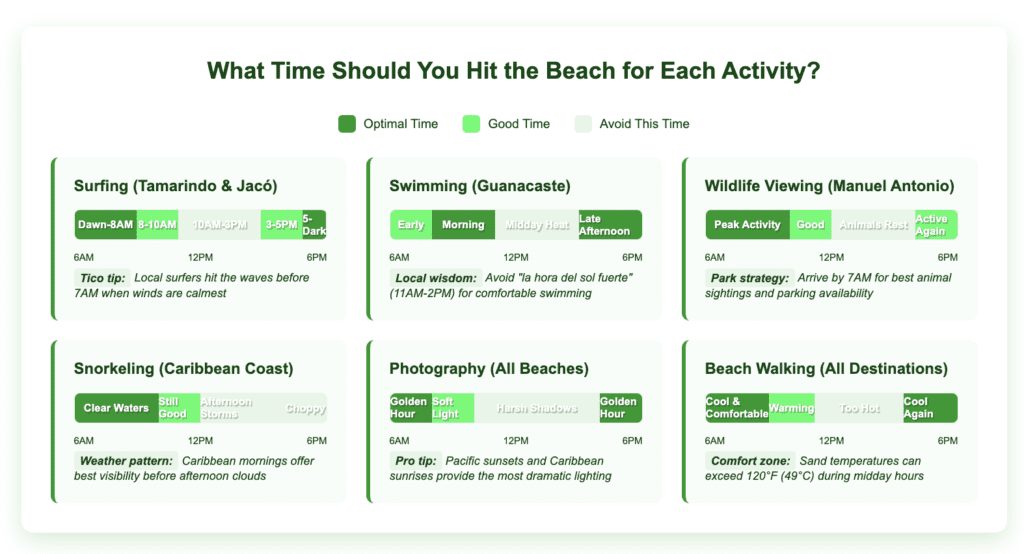
How Do You Choose the Right Beach for Your Trip?
Choose Pacific Coast If:
- Reliable sunshine is your top priority
- You want extensive restaurant and accommodation options
- Surfing is a primary activity
- You prefer shorter drives from international airports
- You enjoy dramatic sunset viewing
Choose Caribbean Coast If:
- You’re interested in cultural immersion
- You prefer fewer crowds and more authentic experiences
- You’re visiting in September or October for summertime
- You don’t mind afternoon rain showers
- You want to experience a different side of Costa Rica
Choose Multiple Beaches If:
- You have 10+ days available
- You enjoy road trip-style travel
- You want to experience Costa Rica’s coastal diversity
- You’re comfortable with longer driving days
- You prefer varied experiences over deep immersion
Transportation Solutions for Every Beach Plan
The right vehicle makes all the difference for Costa Rican beach adventures. Standard cars work perfectly for major beach destinations during dry season, while 4×4 vehicles provide access to remote beaches and confidence during green season conditions.
For major beach destinations like Manuel Antonio, Tamarindo, and Puerto Viejo: Any vehicle type works well on fully paved routes. Economy cars offer fuel efficiency for longer drives, while mid-size vehicles provide more comfort for families.
For remote beaches and off-the-beaten-path exploration: 4×4 vehicles become essential. Ground clearance and all-wheel drive capability open access to hidden beaches and provide security when road conditions deteriorate.
For multi-beach itineraries: Consider mid-size SUVs that balance fuel efficiency with storage space for longer trips between destinations.
Getting the vehicle selection right eliminates stress and opens possibilities. With locations at both San José and Liberia airports, Vamos provides immediate access to your chosen vehicle without additional transportation hassles.

What Are Your Next Steps to Beach Paradise?
Ready to hit Costa Rica’s incredible beaches? Start with these actionable steps:
- Define your beach priorities: Surfing, swimming, wildlife, culture, or relaxation? This determines which coast works best.
- Check seasonal timing: Match your travel dates with optimal conditions for your chosen activities and regions.
- Plan your route logically: Choose beaches that connect efficiently rather than requiring excessive driving between distant locations.
- Select appropriate transportation: Match your vehicle choice to your intended destinations and travel season.
- Book accommodations early: Beach hotels fill quickly during peak season, especially near popular national parks.
Whether you’re dreaming of perfect surf breaks, pristine swimming conditions, or cultural immersion along the Caribbean coast, Costa Rica’s diverse beaches deliver experiences you’ll remember long after returning home. The key is matching your beach choice with your travel style, timing, and transportation strategy.
Start planning your perfect Costa Rican beach adventure today – the waves and sunshine are waiting.
This circuit provides diverse ecosystems, manageable driving distances, and builds from easier wildlife viewing to more challenging cloud forest conditions.


